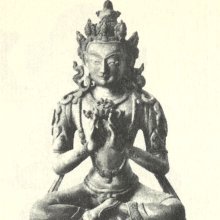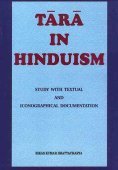Nila, Nīlā, Nīḷa, Nīla: 57 definitions
Introduction:
Nila means something in Buddhism, Pali, Hinduism, Sanskrit, Jainism, Prakrit, the history of ancient India, Marathi, Hindi, biology, Tamil. If you want to know the exact meaning, history, etymology or English translation of this term then check out the descriptions on this page. Add your comment or reference to a book if you want to contribute to this summary article.
Nila has 56 English definitions available.
The Sanskrit term Nīḷa can be transliterated into English as Nila or Nilia, using the IAST transliteration scheme (?).
Alternative spellings of this word include Neel.
Images (photo gallery)
(+3 more images available)
Languages of India and abroad
Sanskrit dictionary
[Deutsch Wörterbuch]
Source: Cologne Digital Sanskrit Dictionaries: Böhtlingk and Roth Grosses Petersburger WörterbuchNīla (नील):—
--- OR ---
Nila (निल):—m. Nomen proprium eines Rākṣasa, eines Ministers Vibhīṣaṇa’s, [Rāmāyaṇa 7, 5, 43.]
--- OR ---
Nīla (नील):—
2) b) nīlaṃ vanaspatim [Spr. 3605.] — h) [Oxforder Handschriften 348,b, No. 818.] —
3) a) η) Nomen proprium einer Göttin [WILSON, Sel. Works 1, 145.] — b) α) auch Indigo [Spr. 4955.] vastra ein mit Indigo gefärbtes Gewand [Oxforder Handschriften 282,b,2 v. u.] — Vgl. mahā .
--- OR ---
Nīla (नील):—, nāsya pāpaṃ cakruṣo (so lesen wir) mukhānnīlaṃ vyeti (wohl so zu lesen) [Kauṣītakyupaniṣad 3,] [?1; vgl. Taittirīyasaṃhitā 3, 1, 1, 2.]
Source: Cologne Digital Sanskrit Dictionaries: Sanskrit-Wörterbuch in kürzerer FassungNīla (नील):——
1) Adj. (f. ā und ī) — a) dunkelfarbig , namentlich blau , dunkelblau , schwarzblau. — b) *mit Indigo gefärbt. —
2) m. — a) Sapphir [Rājan 13,183.] — b) der indische Feigenbaum [Rājan 11,119.] — c) * = nīlavṛkṣa [Rājan 9,78.] — d) *ein best. Vogel. — e) ein dunkelfarbiger Stier. — f) *Name eines der 9 Schätze Kubera's. — g) Beiname Mañjuśrī's. — h) Nomen proprium — α) eines Schlangendämons. — β) verschiedener Männer. — γ) eines Affen im Gefolge Rāma's. — δ) eines Gebirges. —
3) f. nīlā — a) *die Indigopflanze [Rājan 4,82.] — b) eine blau blühende Boerhavia [Rājan 5,121.] — c) *schwarzer Kümmel. [Rājan 6,61.] — d) *eine blaue Fliegenart [Rājan 19,128.] — e) *Du. die beiden hervortretenden Schlagadern vorn am Halse. — f) *Flecken. — g) Nomen proprium — α) einer Göttin. — β) der Gattin des Rāga Mallāra. — γ) eines Flusses [Mahābhārata 6,9,31.] nālā v.l. —
4) f. nīlī — a) die Indigopflanze und Indigo ([Indische sprüche 5843]). — b) *Blyxa octandra. — c) *eine blaue Fliegenart. — d) *eine best. Krankheit. — e) Nomen proprium der Gemahlin Agamiḍha's. —
5) n. — a) die dunkle Farbe [Taittirīyasaṃhitā 3,1,1,2.] [Kauṣitakibrāhmaṇopaniṣad 3,1.] ein dunkler Stoff [Śatapathabrāhmaṇa 14,7,1.20,2,12.] [Chāndogyopaniṣad 8,6,1.] — b) Indigo. — c) = tāliśapattra
2) [Rājan 6,185.] — d) *schwarzes Salz [Rājan 6,95.] — e) *blauer Vitriol [Rājan 13,104.] — f) *eine Salbe von Spiessglanz [Rājan 13,89.] — g) *Gift. — h) eine best. Stellung beim Tanze. — i) ein best. Metrum.
Sanskrit, also spelled संस्कृतम् (saṃskṛtam), is an ancient language of India commonly seen as the grandmother of the Indo-European language family (even English!). Closely allied with Prakrit and Pali, Sanskrit is more exhaustive in both grammar and terms and has the most extensive collection of literature in the world, greatly surpassing its sister-languages Greek and Latin.
See also (Relevant definitions)
Starts with (+788): Nila alumu, Nila avarai, Nila bhatta, Nila chakka, Nila hutan, Nila palai, Nila vaembu, Nila vagai, Nila vaka, Nila vakai, Nila virai, Nila-amalppori, Nila-ammanpaccarici, Nila-c-cemmulli, Nila-chitrak, Nila-citramula, Nila-cumal, Nila-dumphaka, Nila-jakara, Nila-k-katalai.
Ends with (+116): Abhinila, Adigeanila, Adugeanila, Agnila, Agnyanila, Ahinila, Aindranila, Anila, Annila, Anukulanila, Apananila, Aphenila, Arejalanila, Arkanila, Arrukanila, Asyanila, Atinila, Attukanila, Atyanila, Bana-nila.
Full-text (+1257): Nilamani, Nilam, Nilaja, Nilabha, Niladri, Nilaksha, Kamsyanila, Nilaloha, Nilapiccha, Nilashman, Nilaratna, Nilanjana, Nilanjasa, Neela, Kempunilam, Nilavasana, Nilapushpa, Nilamallikai, Nilavarna, Nilalohita.
Relevant text
Search found 134 books and stories containing Nila, Nīlā, Nīḷa, Nīla, Niḷā, Nilā, Ṇīla, Ṇila, Ṇilā, Neelaa, Neela, Nilaa; (plurals include: Nilas, Nīlās, Nīḷas, Nīlas, Niḷās, Nilās, Ṇīlas, Ṇilas, Ṇilās, Neelaas, Neelas, Nilaas). You can also click to the full overview containing English textual excerpts. Below are direct links for the most relevant articles:
Rasa Jala Nidhi, vol 3: Metals, Gems and other substances (by Bhudeb Mookerjee)
Part 1 - Characteristics of Sapphire (nila) < [Chapter XVII - Gems (5): Nila (sapphire)]
Chapter XVII - Gems (5): Nila (sapphire)
Part 2 - Uparatna (2): Rudhra (carnelian) < [Chapter XXVII - Uparatna (minor gems)]
Sahitya-kaumudi by Baladeva Vidyabhushana (by Gaurapada Dāsa)
Text 10.206 < [Chapter 10 - Ornaments of Meaning]
Text 7.8 < [Chapter 7 - Literary Faults]
Text 7.100 < [Chapter 7 - Literary Faults]
Chandogya Upanishad (english Translation) (by Swami Lokeswarananda)
Verse 8.6.1 < [Section 8.6]
Rudra-Shiva concept (Study) (by Maumita Bhattacharjee)
2.11. Rudra as Nīlagrīva or Nīlakaṇṭha < [Chapter 6a - The Epithets of Rudra-Śiva]
2.3. Rudra as Śarva < [Chapter 6a - The Epithets of Rudra-Śiva]
2.17. Rudra as Śitikaṇṭha < [Chapter 6a - The Epithets of Rudra-Śiva]
Vakyapadiya of Bhartrihari (by K. A. Subramania Iyer)
Verse 3.14.52 < [Book 3 - Pada-kāṇḍa (14): Vṛtti-samuddeśa (On Ccomplex Formation)]
Verse 3.14.465 < [Book 3 - Pada-kāṇḍa (14): Vṛtti-samuddeśa (On Ccomplex Formation)]
Verse 2.365 < [Book 2 - Vākya-kāṇḍa]
Vishnudharmottara Purana (Art and Architecture) (by Bhagyashree Sarma)
6. Materials for Colours Used in Painting < [Chapter 5 - Painting and Image Making]
6. Different Types of Temple < [Chapter 4 - Temple Building]
1.3. Elements of Drama (h): Sentiment (Rasa) < [Chapter 3 - Drama and Dance]
Related products








